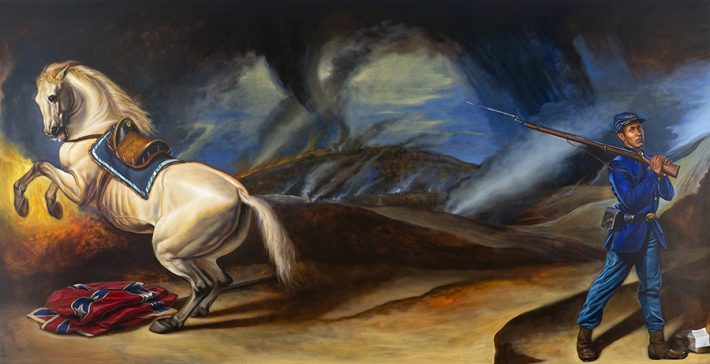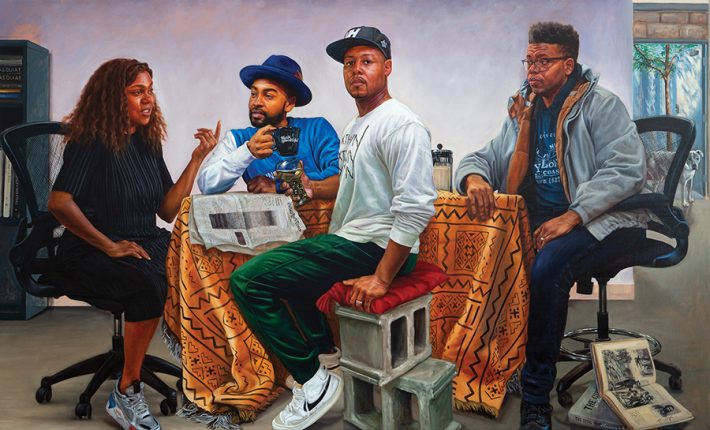Exhibition Dates: October 2–December 18, 2021
Opening Reception: Saturday, October 2 from 6–9 pm
Gallery Location: 432 Julia Street, New Orleans, LA 70130
Hours: Tuesday–Saturday, 10 am–5 pm
Contact Info: 504.522.1999; arthurrogergallery.com
The Arthur Roger Gallery is pleased to present A New Republic, an exhibition of work by Mario Moore. The exhibition will be on view at the Arthur Roger Gallery, located at 432 Julia Street, from October 2–December 18, 2021. The gallery will host an opening reception with the artist in attendance on Saturday, October 2 from 6–9 PM.
In A New Republic, artist Mario Moore confronts the precarious state of American society. Moore states that the country is experiencing déjà vu of racial division, political diatribes, and needless death. Through painting, drawing, and printmaking, A New Republic tells the modern story with imagery and the history of the Civil War. By dipping into the imagery of the Civil War, the artist holds the mirror for modern America to see its flaws. The artist draws parallels between the 1860 and 2020 presidential elections. Ultimately, a new nation emerged from both elections, and the artist asks, “Where does Black agency fit within this context?”
Through historical and genealogical research, Mario Moore discovered that his third-great uncle, Thomas Moore, fought in the Civil War. The elder Moore’s image is throughout the exhibition. He is featured in three portraits as well as The Great Reckoning, a 17-foot wide magnum opus, which is the largest painting that Mario Moore has ever created. Thomas Moore is stationed on the right side of the canvas and represents the Black Lives Matter movement. On the left side is a white horse representing death, the Proud Boys, and white supremacists as well as Robert E. Lee’s warhorse. The horse is trampling a Confederate flag which is in the foreground since we haven’t dealt with the symbol since the Civil War. The space between the horse and the figure represents the divide in the nation today.
“How is it possible that we are still faced with the same anger and public opinion when it comes to Black men and weapons today?” says Moore. Mario imagines what it was like for Black men that fought for a nation that used Negro regiments in the American Civil War as cannon fodder. The US death toll from COVID-19 is rapidly approaching the loss of life due to the Civil War. Moore turns to history to determine the role of an artist in times of uncertainty. In 1624 while quarantining in Palermo Sicily, Flemish painter Anthony van Dyck painted Saint Rosalie—the patron saint of Palermo—interceding for the city during an outbreak of the plague. David Bustill Bowser, a self-taught Black artist, hand-painted silk flags for 12 Negro regiments during the Civil War and was a prominent abolitionist. The Council considers this question of the artist role by replacing usual government officials found within the Dutch portrait format with contemporary artists.
Mario Moore was born in 1987 in Detroit, MI where he currently resides. He acquired a BFA from the College for Creative Studies in Detroit and an MFA from Yale University. He was recently awarded the prestigious Princeton Hodder Fellowship at Princeton University and has participated as an artist-in-residence at Knox College, Fountainhead Residency, and The Josef and Anni Albers Foundation. His work is in several public and private collections including the Detroit Institute of Art, The Studio Museum in Harlem, Princeton University Art Museum, and the LSU Museum of Art. Moore’s work has been featured in numerous exhibitions including The Smart Museum, Chicago; the Smithsonian Museum traveling Sites Exhibition; Xavier University Art Gallery, New Orleans; the Urban Institute of Contemporary Art, Grand Rapids, MI. He currently has a solo survey exhibition at the Charles H. Wright Museum, Detroit, 2021.
For more information, press, or sales inquiries, please contact the Arthur Roger Gallery at 504.522.1999 or email gallery@arthurrogergallery.com. More information can also be found on our website (arthurrogergallery.com).


